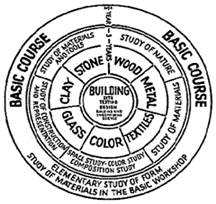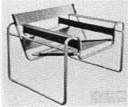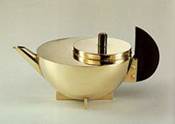Exercise 1. Read and memorize the
following words and word combinations:
| 1. handicraft | ремесло, ручна робота/ ремесло, ручная работа |
| 2. Werkbund | Веркбунд, художньо-промислове об’єднання / Веркбунд, художественно-промышленный союз |
| 3.to add | добавити/ добавить |
| 4. solution | рішення/ решение |
| 5. to overlook | не розгледіти/ не заметить |
| 6. Arts and Crafts School | школа декоративно-прикладного мистецтва / школа декоративно-прикладного искусства |
| 7. master craftsman | вмілий майстер/ искусный мастер |
| 8. functional design | функціональний дизайн/ функциональный дизайн |
| 9. aim (syn. purpose) | намір, мета/ намерение, цель |
| 10. inception | початок/ начало |
| 11. direction | спрямування/ направление |
| 12. to rescue | врятувати/ спасти |
| 13. to encourage | заохочувати/ поощрять |
| 14. artisan (syn. craftsman) | ремісник/ ремесленник |
| 15. to set out | намірятися/ намереваться |
| 16. to elevate | підвищувати/ повышать |
| 17. craft | ремесло/ ремесло |
| 18. to maintain | підтримувати/ поддерживать |
| 19. attempt | спроба/ попытка |
| 20. to gain independence | самовизначитися/ самоопределиться |
| 21. immensely | дуже сильно/ очень сильно |
| 22. to take for granted | вважати за звичайну річ/ считать само собой разумеющимся |
| 23. achievement | досягнення/ достижение |
| 24. tubular | трубчастий/ |
| 25. upholstered | оббитий тканиною/ оббитый материей |
| 26. workshop | майстерня, цех/ мастерская, цех |
| 27. visual language | мова візуального спілкування/ язык визуального общения |
| 28. to appreciate | оцінювати/ оценить |
| 29. faculty member | викладач навчального закладу/ преподаватель учебного заведения |
| 30. lighting fixture | освітлювальна апаратура/ осветительная аппаратура |
Exercise 2. Guess the meaning of the following international words:
Experiment, architecture, industrial, construction, architect, economics, element, modern, creative, practical, isolation, to combine, lamp, contact, leader, basis, graphic design, classics, furniture, revolutionary.
Exercise 3. Find in the text synonyms to the following words:
Craftsman, to work, to combine, artist, aim.
Exercise 4. Find in the text antonyms to the following words:
To see, airy, difficult, creative.
Exercise 5. Find in the text derivatives containing suffixes 1. -tion/sion; -men; -er/or; 2. -al, -ive, -ic; -ant; and 3. -ly of the following words, say to what part of speech they belong and translate them:
1. to educate; to construct; to move; to integrate; to imagine; to direct; to isolate; to govern; to achieve; to design; to innovate;
2. industry; creature; practice; function; individuality; 3. literal; previous; basic; significant; repeated; cooperative; second; eventual; immense;II Reading
Exercise 6. Read and translate:
Notes:
Pay attention to pronunciation:
Weimar; Dessau; Walter Gropius ; Hannes Meyer; Ludwig Mies van der Rohe; Marcel Breuer ;
Gunta Stölz; Anni Albers; Bayer; Moholy-Nagy; Tschichold.
Text A The Bauhaus  Diagram for the structure of teaching at the Bauhaus Diagram for the structure of teaching at the Bauhaus |
The Bauhaus was founded in 1919 by an architect named Walter Gropius. He came from the Werkbund movement which sought to integrate art and economics, and to add an element of engineering to art. The Werkbund movement was unable to achieve this integration, but the founding of the Bauhaus saw the solution that had previously been overlooked. The Bauhaus was founded by the combining of the Weimar Art Academy, and the Weimar Arts and Crafts School. Students at this new school were trained by both an artist and a master craftsman, realizing the desires of Gropius to make modern artists familiar with science and economics, that began to unite creative imagination with a practical knowledge of craftsmanship, and thus to develop a new sense of functional design.
The school had three aims at its inception that stayed basically the same throughout the life of the Bauhaus even though the direction of the school changed significantly and repeatedly. The first aim of the school was to rescue all of the arts from the isolation in which each found itself, to encourage the individual artisans and craftsmen to work cooperatively and combine all of their skills. Secondly, the school set out to elevate the status of crafts, chairs, lamps, teapots, etc., to the same level enjoyed by fine arts, painting, sculpting, etc. The third purpose was to maintain contact with the leaders of industry and craft in an attempt to eventually gain independence from government support by selling designs to industry. With these at its basis the Bauhaus began and influenced our lives immensely in ways that most people probably take for granted.  Tubular chair by Marcel Breuer Tubular chair by Marcel Breuer |
 Metal work by Marianna Brandt Metal work by Marianna Brandt |
III. Grammar
